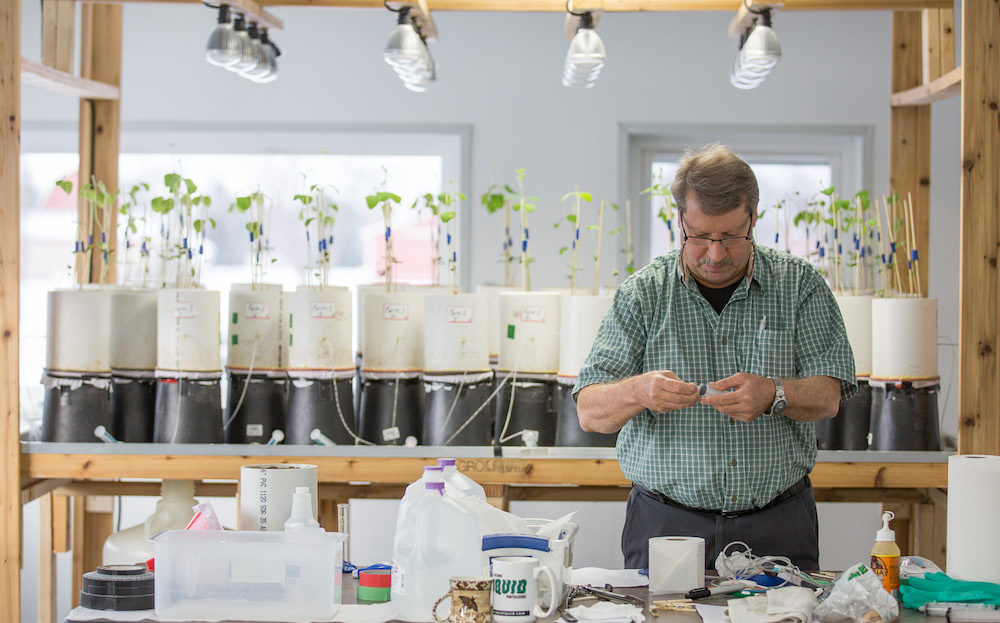Agriculture often gets a bad rap for contributing to environmental problems. And, in fact, we have learned many lessons about how we treat the soil.
We know that thousands of years of plowing, deforestation and erosion have left some soils in dire shape. When the soil is degraded it releases carbon dioxide into the atmosphere and this has serious consequences for the climate. However, healthy soil can be a major sink for carbon, meaning it actually removes carbon from the atmosphere. But this fact hasn’t been well known.
Agricultural practices like no-till farming, increasing crop diversity, the inclusion of cover crops, application of microbial products and composting are all proven ways to put carbon back into the soil.
However farm economics and increased regulations complicate the process of farming, and therefore land stewardship. While growers are understandably trying to maximize crop yield, they also need to work toward a renewed commitment to the land. Sound agronomic decisions enable environmental benefits and a better cropping system.
As a dynamic natural body, soil is teeming with life that performs numerous ecosystem functions, including recycling of dead and decaying organic matter into plant nutrients. Plants can’t differentiate between nutrients supplied by organic and/or inorganic amendments.
Therefore, replacing what is taken out of the soil to produce a crop will keep it fertile and as productive as possible. The strategy is to shift from soils cultivated with marginal inputs to soils economically managed to unlock the soil’s potential and make organic carbon, nitrogen, phosphorus and potassium available to plant uptake.

Dr. Massri discusses his research with growers.
Impact of Productive Soils
What is “soil quality?” Soil quality is related to soil functions — or what it does — and the three dimensions of soil health represented by the biological, physical and chemical compounds. To improve soil quality, the soils capacity as a dynamic and biologically active entity must be improved. This serves to sustain multiple ecosystems. So soil health is a finite and dynamic living resource.
The difficulty lies in that the three-dimensional aspects of soil health may not directly or immediately impact crop yield. With growers already facing difficult markets, this can pose a real economic concern. But the long-term impact of increasing the productivity of the soils can have a positive impact on a grower’s bottom line. A vital and healthy soil will be highly adverse to environmental threats and will suppress disease.
There are benefits to converting from tillage to no-till practices, which include building soil organic matter over time. One problem we have environmentally in agriculture is water quality — nitrates and phosphorus are leaching into the water supply. The more organic matter in the soil, the more water-holding capacity it has, so less nitrates and phosphate phosphorus are leached into the water system.
The Carbon 'Engine'
When plants photosynthesize using the sun’s energy they take carbon dioxide from the air and transform it into carbon the plant uses to grow leaves, stems, and roots and store the excess carbon in the surrounding soil. The stored carbon feeds microbes and fungi, which in turn provide nutrients for the plant.
Increased microbial biomass means enhancement of communication between microbes and plant roots in the rhizosphere (the ‘hot spot’ for soil microbes is in this area of soil surrounding plant roots).
The microbes supply the roots with minerals and the roots exudates provide the microbes with energy-rich sugar. Nutrients for energy — a fair trade — and the return is great in enhancing the plant’s ability to take up water and nutrients from the soil. Soil microbes, directly and indirectly, mediate about 90% of soil functions in decomposing dead matter into soil organic matter (SOM).
Microbes respire carbon dioxide (CO2) and methane (CH4) to the surrounding soil and air, making essential nutrients, such as nitrogen compounds, available to plants and other soil organisms. This process also results in stored carbon in soil humus, and decomposing humus which releases CO2 to the air via soil respiration.
Root-mediated rhizospheric communication with soil microbes and soil organic carbon is considered the most diverse and integrated ecosystem, thus providing an improved environment for soil health.
All organisms in the biosphere need nitrogen to build their DNA, RNA and protein molecules. Because plants transfer carbon into the soil via photosynthesis, the nitrogen cycle becomes critical to building strong healthy soil.
Current research indicates that the length of time soil carbon persists in humus and other soil organic carbon components depends on many ecosystem interactions between soil organic carbon and microbes, minerals, moisture and temperature.
New Soil Health Test
The arising question now becomes how growers measure soil health and improve it in a manner that is economically viable. Is it a management system to adopt and improve, or it is a parameter to routinely measure? And finally, how do growers couple soil health with yield?
In agriculture, improved management practices have to make sense in dollars and cents. Sustainable agriculture means stewardship of the land, air and water — but it also means doing this in a way that is profitable over the long-term.
Sustaining and further improving crop yield is the best objective of soil health. Continuous improvement of crop yield is extremely dependent on how we plan to invest and sustain the soil ecosystem to withstand environmental threats and stripping of key nutrients needed to sustain agriculture.
Soil microbial respiration activity tests directly measure biological activity and are the best indicator of the biological status of the soil community. Unfortunately, soil microbial activity respiration tests are still expensive, few laboratories are conducting the tests, and it’s time-consuming.
However, AgroLiquid has developed a gel-colorimetric method to appraise soil health using accurate spectrophotometry readings measured directly in the field, without the need of soil preparation, systematic spectrometer calibration and laboratory incubation. The method was tested in the field and can be run in the lab.
We are only beginning to understand what is right beneath our feet. What we do understand is that we need to allow the plants to capture carbon dioxide in their leaves and pump the carbon down through their roots to feed hungry microorganisms living in the soil.
No-Till Farmer's Focusing on Smarter, Sustainable Fertilizing Strategies series is brought to you by AgroLiquid.
For over 35 years, AgroLiquid has been on a mission to engineer the best plant nutrition products while safeguarding your crops, the soil and the environment. Click here to learn more about AgroLiquid's suite of fertilizer products and agronomic services.








